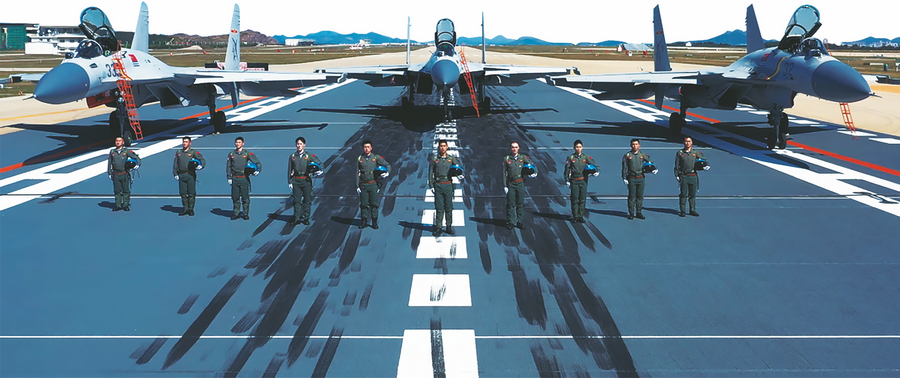

As China's carrier-based aircraft development takes flight, Zhang Yuliang shows he's got what it takes in his high-stakes career as a pilot, Wang Xingwei reports.
Since its release during this year's May Day holiday season, the Chinese movie Born to Fly has brought the work of air force test pilots into the spotlight, garnering rave reviews from both audiences and critics.
As depicted in the movie, the unexpected may occur when elite pilots soar to new heights, leading them to face extreme conditions and even rub shoulders with death to accomplish their mission. And for Zhang Yuliang, a real-life carrier-based aircraft pilot, the touch-and-go maneuvers seen in the movie are pretty much his everyday life.
"Our fighter jets are among the most agile and versatile aircraft, but of course, flying poses extreme challenges as well as risks," said the 31-year-old pilot.
Take grayout as an example. When large aircraft movements are executed, the pilot pulls high positive g-forces, leading to high pressure that can restrict blood flow to the brain. "One may experience a progressive loss of vision, with the sense of color dimmed and peripheral vision reduced. In serious cases, one may not even be able to see at all," Zhang explained.
But despite numerous challenges, Zhang has managed to overcome physical and mental limits and enjoy his high-sky moments. "I love the exhilaration of flying fighter jets, which are as swift as the wind and as quick as lightning. It's a challenge I love."
In China, the development of carrier-based aircraft — a naval aircraft designed for operations from aircraft carriers — has just begun. In order to be a qualified aircraft pilot, Zhang and his contemporaries had to undergo rigorous physical and psychological training. According to him, experienced pilots may receive refitting training where they are recruited and switched to carrier-based aircraft, and he was among the first batch of pilots to directly receive the training.
In this training process, the pilots are selected for a cadet scheme to become carrier-based aircraft pilots and are taught to fly the aircraft.
"Our carrier-based aircraft have their own specific training requirements," noted Zhang. For instance, landing can be very difficult since the aircraft carrier's runway is so short — only about 200 meters long — which is barely one-tenth of the length of a normal runway.
"Viewed from above, it's as small as a leaf. So landing on an aircraft carrier demands high-precision accuracy, with very little room for error," Zhang added.
After going through high-intensity and high-frequency training, Zhang became a top performer among the trainees, once executing nearly 100 zero-error maneuvers in 60 seconds and successfully bringing his plane back to base.
"Generally, the first pilot to take off from the carrier should have highly reliable skills and good psychological attributes. So Zhang Yuliang was chosen as the first pilot, and was expected to take up the leading role," commented Xu Can, one of Zhang's instructors.